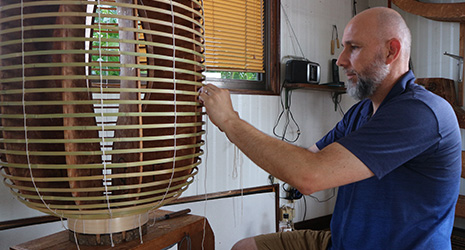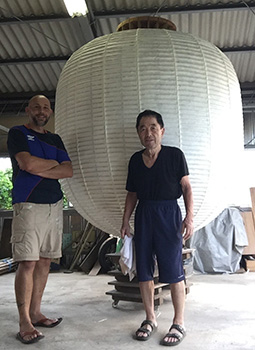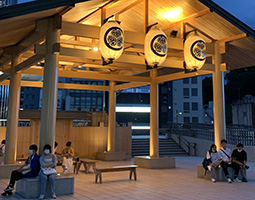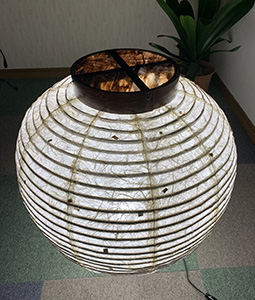July 2022
Succeeding the Suifu Chochin Tradition

Jeff Rudge at work on a Suifu chochin

Jeff Rudge and his father-in-law, the paper lantern maker Iijima Minoru (right), in front of a huge Suifu chochin 
Suifu chochin light up a Mito station waiting area 
A Suifu chochin incorporating stained glass made by Jeff Rudge

Jeff Rudge, a German/British man raised in France who has always liked to make things, is continuing the tradition of Suifu chochin while also working on making paper lanterns in a new style.

Paper lanterns (chochin) are indispensable as a form of lighting to decorate ceremonies and festivals at venues such as temples and shrines in Japan. A paper lantern is a traditional lighting fixture in Japan, typically comprising a bamboo frame onto which washi paper is pasted and inside which a candle is placed. The candle is lit and the paper lantern radiates light*. The soft expression of the light through the washi paper is quite elegant.
One of the major paper lantern production areas in Japan is Ibaraki Prefecture, whose lanterns are known as “Suifu chochin” and go back about 400 years. In their heyday, there were more than 30 workshops in Mito City, historically known as “Suifu,” Ibaraki Prefecture. In recent years, the number has continued to decline to about three today.
Iijima Minoru, who has worked on the paper lanterns of numerous famous temples and shrines in Japan such as Kanda Myojin shrine in Tokyo and Zenko-ji Buddhist temple in Nagano Prefecture, is one of the valuable craftsmen who continue to preserve the traditional way of making Suifu chochin. Minoru turned 83 this year, but fortunately he has a reliable successor, and that is Jeff Rudge.
Jeff was born in Switzerland to an English father and a German mother, after which he was raised in France. Interested in different countries and unknown cultures, Jeff moved to New Zealand on a working holiday. He married a Japanese woman he met on an apple farm where he worked in 2002, and that woman was Minoru’s daughter.
Jeff says that he became very interested in the Suifu chochin that Minoru was making when he visited his wife’s parental home for the first time after getting married.
“Influenced by my grandfather who was good at handicrafts, I have also loved making things from a young age,” says Jeff. Minoru was happy to oblige Jeff when he asked him to “teach me how to make lanterns.”
In 2005, Jeff moved to Naka City, which is adjacent to Mito City, where he taught English at a local middle school. In 2017, he started learning the lantern-making craft. Minoru revealed that the number of paper lantern-making craftsmen is decreasing in Mito and there are no successors, to which Jeff said, “Then I will succeed you.” He began his training in earnest in 2017.

In most paper lantern-making areas in Japan, bamboo is split into long thin strips and bent to form the lantern framework, but the Suifu chochin is characterized by the use of thick, individual bamboo strips shaped into rings using a mold that are then tied together with thread to form the lantern framework. Jeff learned this traditional technique from Minoru, and he says this was the most difficult process, taking three or four years to master. After making the bamboo framework, sturdy washi paper is pasted onto it. The resulting Suifu chochin is very robust.
“The biggest attraction of Suifu chochin is that you can make something very big and powerful,” says Jeff, who has made a paper lantern about 2 meters high. Meanwhile, the largest lantern that Minoru has ever made was 3 meters high and 1.4 meters in diameter.
Now, Jeff envisions the paper lantern as a new style of lighting fixture. One of his ideas is to incorporate stained glass, a craft he learned from his maternal grandfather, into his lanterns. Jeff’s grandfather was a plumber but was also a skilled craftsman. After retiring, he took up the stained glass craft which he taught Jeff, who visited him in Germany at least once a year. “I think mixing traditional Japanese paper lanterns with stained glass would be a good blend of the skills I have learned here in Japan and the ones I have learned through my grandfather in Germany. Whenever I work with stained glass I think of my grandfather,” says Jeff. Although it is still in the prototype stage, he has given friends lanterns based on this new idea, which were well received.

“Paper lanterns are made of bamboo, thread, and washi paper, materials that can be taken from nature and returned to nature. It would be good to incorporate them more into our lives around the world in the future,” Jeff says.
“Sometimes things do not go the way we want when we are working with natural materials. But it is precisely because we take the time and effort to overcome the challenges that we are able to complete attractive works. Every day, I’m fighting for ‘perfection.’”
* These days paper lanterns typically use electric light sources.

